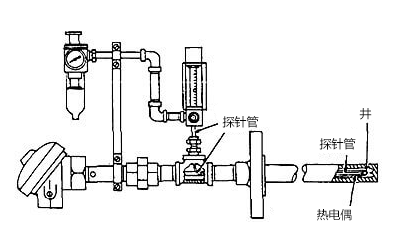
Thermocouple puppet green rotation effect
The "K" hotcoust puppet is widely used in temperature measurement and control of about 2000 Hualhi. They run well in the oxidation atmosphere.
However, if there is a reducing gas (such as hydrogen), the reduction atmosphere may be in contact with the wire. Under these conditions, there are only a small amount of oxygen, and chromium in chromium alloy will be oxidized. This will reduce the power output and the thermocouple reading. This phenomenon is called "vascia" due to the color of the affected alloy.
Although it is not always green, chromium alloy lines will form mottled silver skin and become magnetic. A simple way to check this problem is to check whether the two wires are magnetic. (Usually, chromium alloy is non -magnetic.)
Hydrogen in the atmosphere is a common cause of vasters. At high temperatures, it can spread through solid metal or complete metal heat sleeves. Even the sheath of magnesium oxide insulating thermosi can prevent hydrogen from entering.
In order to overcome this problem, the "purification" heat suite was used. Here, the small pipes in the overheat tube flow down to clear any hydrogen entering the well. (See the figure below) The small air flow is heated during the flow of the pipe, so it will not cool the sensing knot.

Figure: Installing the sweeping pipe can introduce the air into the heat suite. The air eliminates the hydrogen that enters the well, and the hydrogen will form a restore atmosphere around the thermocouple.
K -type hot electric puppet
The K-type thermocouple consists of nickel 10% chromium (+) line and nickel 5% aluminum and silicon (-) line. This type of thermocouple can only be used in the oxidation or inertial atmosphere between -200 ° C to 1260 ° C (-330 ° F to 2300 ° F) at a working temperature range. Because they have excellent antioxidant properties compared to E, T or J, they are most widely used for temperatures above 540'C (1000 "F).
Avoid some situations when using a K -type hot electric puppet. Due to the evaporation of chromium in the positive electrode element, the vacuum application should not be used. The K -type thermocouple should not be used in a sulfur -containing environment, because both components will be quickly corroded, and the negative electrode components will eventually cause mechanical failure due to crispness. You should also avoid using the atmosphere.
Low oxygen levels can lead to vascopic phenomenon. Among them, chromium in the element starts to oxidize, resulting in large negative drift in the calibration. When the thermocouple is used between 815 ° C and 1040 ° C (1500 ° F to 1900 ° F), the most obvious vascia is the most obvious.
To avoid this problem, a large inner diameter protection tube should be used to maximize the internal air circulation or install oxygen absorbers at the bottom of the protective tube. If Green-ROT is a serious problem, it should be installed with N-type hot electric puppets.
The negative electrode or Kn of the K-type thermocouple can be described in any of the following names: Alumel2, Hai-KN1, Thermokanthal-KNS, T-2S, Nickel-Silicon or Nial+. The positive element or KP of the K-type thermocouple can be described in the following names: chromel2, Tophel+, Thermokanthal-KPS, Nickel-Chrome, T-13 or Hai-KP1.
N -type hot electric puppet
N-type thermocouple consists of nickel -14% chromium-1/2% silicon (+) line and nickel 4 1/2% silicon-1/10% magnesium (-) line. The N -type thermocouple is the latest member of the ISA series.
It is developed for use in the same conditions as K type. Type N should be used in the oxidation or inert atmosphere, and the operating temperature range is -200 ° C to 1260 ° C (-330 ° F to 2300 ° F).
Compared with the K type, adding silicon and chromium to make this type of thermocouple is more resistant to vasters and smaller drift. The negative element or Nn of the N-type thermocouple can be described by any of the following names: Nisil, Nickel Silicon or Hai-Nn1. NP or NP of NP of NP can be described by any of the following names: Nicrosil, Nickel-chromium-silicon or hai-np1.

